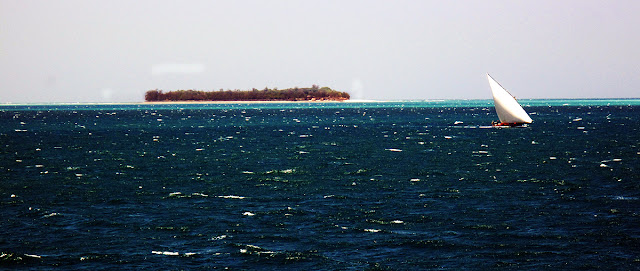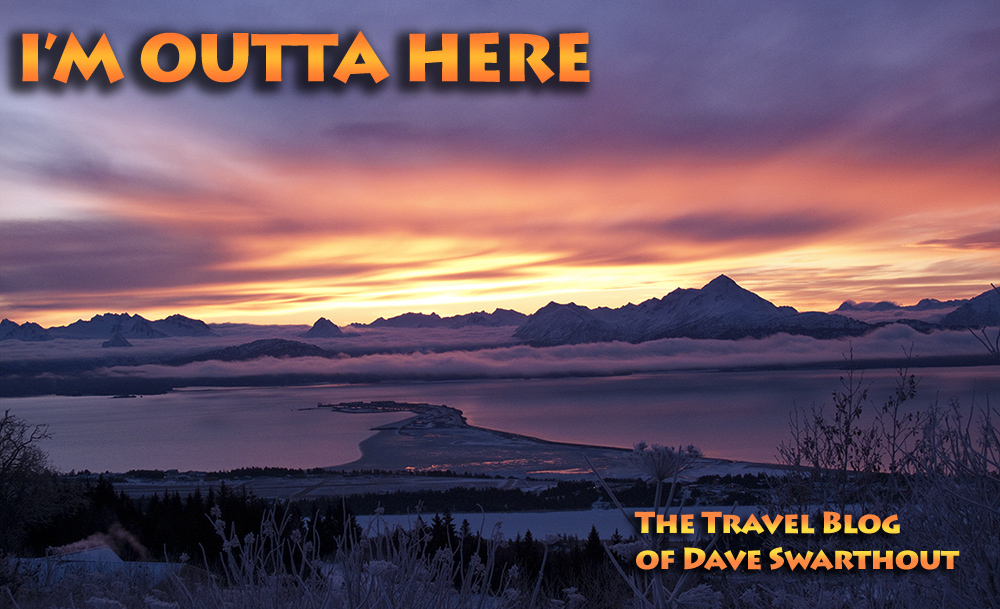From Nairobi to Ngorongoro, the Serengeti and Zanzibar
Zanzibar! The name alone is enough to tantalize and excite the imagination. My friend Kirk has been here before, quite a few years ago now, and my many conversations with him about his travels in Africa and his visit here have always fascinated me. We arrived this morning after spending a night in Stone Town in the old city. Some of our party did side trips to spice farms and the old slave prisons but a few of us opted to do nothing. Zanzibar was a major center of commerce for the spice trade as well as an important slave market in the old days and deserves a quick Google look up if you're interested. But lest I get ahead of myself I need to step back a bit in order to fill you in on our travels over the the past few days -- and very interesting days they were. When I last wrote we had just finished visiting Masai Mara Park in southern Kenya.
 |
| Alaskan travelers at Kudu Camp, Karutu, Tanzania |
 |
| I had a good seat in our Land Cruiser |
 |
| Ngorongoro Crater in morning mist |
 |
| Bull elephant - Ngorongoro Rim |
 |
| Early morning view of African hills from the Crater rim |
We saw cheetahs again in the Crater. I include a photo of the "traffic jam" that results when a viewing opportunity as sought after as the pair of cheetahs in my photo presents itself. Everybody wants to see a cheetah so when one gets spotted the call goes out on the VHF radios and all tour operators within range converge immediately on the spot bringing along their grateful clients to oooh and aaah over the animal. One might hope to be the only one around when an interesting animal is spotted but that's seldom the case. These parks of full of people like us, people who I laughingly label experiential dilettantes, and who can afford to hire a car and driver to make forays "into the wilds" of Africa such as we find it nowadays.
 |
| Everybody wants to see the cheetahs (click to view full size) |
 |
| Cheetahs on a hunt - Ngorongoro Crater |
 | |
| Spotted hyenas - Ngorongoro Crater |
 |
| We got quite close to some of the animals |
After a bone jarring ride over some of the roughest roads I've ever been on (and over which our drivers pushed the old Toyotas at speeds approaching 60 mph) we crossed into the Serengeti late in the day. We took a short drive in search of animals but didn't see much. It was a bit of a disappointment after the bountiful Ngorongoro but near dusk we finally managed to see a leopard. It was not close to us and wasn't doing anything, merely lazing on one of the lower branches of a "sausage tree". Too far away for a photo. We also saw a group of giraffes and some gazelles. There was some rain coming in and I got a good photo of the gazelles with the distant squall in the background.
Just before we drove to our campsite I took this photo of a tree with some nice evening light backing it.
We drove to a public campsite near the center of the park and set up our tents. Dinner soon followed and after a bit of chatting with our fellow travelers we turned in. It had been a long day. We had been up at 6 am so as to have plenty of time to get into the Crater early. The word went out that tomorrow's start was to be at 6 am. That meant we had to be up at around 5 o'clock for breakfast and to pack a lunch for a longish tour of the park. We would finish watching animals and then drive all the way to Arusha so we could be in a better position for the long drive to Dar Es Salaam on the coast the following day, which would be another early day. We had a choice to make concerning this drive. And luckily we didn't know what the starting time for that trip would be or we might have made a different decision. If we wanted to spend 4 days at the beach on Zanzibar then we had a 700 km drive to Dar. If we settled for only 3 days on the beach we could get up later and divide the long trip in half. We unanimously voted to get up early, make the long drive and spend 4 days on the beach.
But let's first return back to our last day in the Serengeti. Having dragged ourselves out of bed long before dawn we were breakfasted, in the Land Cruisers and out on the plains before dawn. I got a nice shot of the sunrise that day.
The Serengeti is immense. If I thought the area encompassed by my gaze in Masai Mara was on a grand scale, I had to revise my thinking now because the scale here was grander still. Seemingly endless grass covered plains stretch to the horizon on all sides. It's big country, stark, and very flat. Again, we didn't see all that many animals with the notable exception of zebra and herds of wildebeest. These strange looking antelope were forming up for the big migrations that would begin when the water holes dried up during the long parched summer ahead. Many thousands of these critters will then move north, following the rain and the green grass. And the predators that depend on the wildebeest for food will come along as well. Eventually they will cross the Mara River en mass, near where we had lunch a few days ago in the Masai Mara. There the big crocs await to take them as they struggle to cross the river.
Amazingly, we saw more cheetahs. I had the idea, whether correct or not I still don't know, that cheetahs were an endangered species. It seems as though we saw them everywhere we turned.
 |
| Cheetahs - Serengeti |
The Serengeti is studded with many interesting rock formations called kopjes. The term derives from the Dutch word for head. They were interesting little oases in an otherwise featureless and grassy expanse. We drove around several hoping to coax some wildlife into view but all we spotted were some hydraxes and a few vultures.
Then just before we were about to point our noses north towards Arusha, Hamadi, our driver, got a call on the radio. Leopards had been spotted a few miles from where we were. Off we sped and sure enough, there in a tree not far from where we'd spotted the lone leopard the night before, was a female leopard and two cubs. What made this sighting especially cool was that she had a small animal, a dik-dik perhaps, in her jaws and when we arrived on the scene she was carrying it up on to the tree to hide it from other predators. It would feed her and her cubs for a couple of days. Leopards are relatively small compared to a lion or hyena, the latter being one of those animals that can steal a leopard's meal right now. A leopard is apparently no match for a hyena intent upon taking what it can. Later I reckon one of the cubs had been playing with the dik-dik because it fell from the tree. Mom immediately jumped down and fetched it returning it to an even higher branch this time. It was an interesting scene to watch because most of the cats we had seen earlier were doing nothing much other then sitting there acting oblivious to the many observers clustered about. I don't have photos of the leopards because once again we were just too far away for my camera to capture a good, detailed photo. But Pete and Desan, both having long lenses on new dSLRs, were snapping away furiously.
As I add photo after photo of animals to this blog I had this thought - you can see all these animals and more, and in higher quality, just by going to Google Images. But I do want to include one more by special request from my buddy Kirk. Here is your warthog photo, Kirk.
Oh, I beg your pardon. I must add just one more. We saw tons of zebras. Zebras, along with wildebeest, were the most common animal we saw. But during our drive in the Ngorongoro Crater Hamadi pointed out this pair and described their interesting pose. He called it "zebra pairs resting for mutual protection" or something like that. When positioned like this they can watch for predators in all directions. One of them is watching us as this shot was made but ordinarily its head would also be resting on the other ones back.
 |
| Zebrras - a pair of them resting for mutual protection - Ngorongoro Crater |
 |
| Mt Meru at sunrise - on the road to Zanzibar |
After suffering through a very long truck ride through the country, enduring almost two hours of heavy traffic in Dar Es Salaam after that, and then a ferry ride to a peninsula opposite the city, we finally arrived at a very nice campsite on the Indian Ocean. We had been in the truck for over 15 hours! We took a dip in the ocean, ate whatever was put in front of us and fell into our tents for a well deserved rest. Next day we would board another ferry, a fast ferry, and make the 40 mile run to Zanzibar in about 2 hours. Our hotel here, while not cheap at $75/night, is not outrageously expensive either because it's a fantastic room right on the beach. That brings me, and you my dear friends, up to the present.
Time to pack. Later this morning we'll leave this beautiful island as we begin moving toward Malawi. We will spend two more nights in Tanzania as we make that journey. I haven't done much of anything other then to enjoy the beach and the comfort of our very nice air conditioned room here at the Sunset Bungalows since we got here four days ago. We continue heading south into Malawi, Zambia, Zimbabwe and finally Victoria Falls. Three more countries to add to my "life list." Talk to you later....
 |
| Zanzibar Channel |













